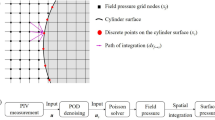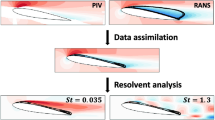Abstract
The present work proposes to analyze the performance of five eddy-viscosity turbulence models in predicting an internal single-phase incompressible turbulent flow through an elbow pipe. Validation is achieved by comparison with LES and experimental benchmark results. Particular emphasis is placed in the study of the velocity fields under challenging conditions in terms of turbulence modeling. Ultimately, the analysis aims to determine the most adequate model among the analyzed ones in terms of accuracy, envisioning further application in multiphase flows. Results show that the SST closure is the most appropriate turbulence model to predict the velocity profile in regions of significant streamline curvature, whereas, in the presence of high adverse pressure gradients, the most appropriate one is the realizable \(k-\epsilon\) model. Furthermore, a quantitative analysis suggests that a modification to the \(F_{1}\) blending function in the SST model may improve the mean velocity agreement with LES benchmark results in the near-wall region located downstream of the bend.











Similar content being viewed by others
References
Bradshaw P (1987) Turbulent secondary flows. Annu Rev Fluid Mech 19:53–74
Bredberg J (2000) On the wall boundary condition for turbulence models. Chalmers University of Technology, Department of Thermo and Fluid Dynamics. Internal Report 00/4. Goteborg
Breunig J (2017) Which turbulence model should you use for your CFD analysis? https://www.xceed-eng.com/which-cfd-turbulence-model/
Carneiro J, Kaufmann V, Polifke W (2009) Numerical simulation of droplet dispersion and evaporation with a moments-based CFD model. In: Proceeding of 20th international congress of mechanical engineering, pp. 15–20
Celik I, Ghia U, Roache P, Freitas C (2008) Procedure for estimation and reporting of uncertainty due to discretization in CFD applications. J Fluids Eng Trans ASME. https://doi.org/10.1115/1.2960953
Conde K (2018) Geração de malhas para geometrias complexas e problemas conjugados de transferência de calor em coletores solares híbridos aletados. Ph.D. thesis, Realização de Instituto Tecnológico de Aeronáutica. São José dos Campos: ITA
Darwish M, Moukalled F (2016) The finite volume method in computational fluid dynamics. Springer, Cham
Davidson L (2015) An introduction to turbulence models
Duraisamy K, Spalart P, Rumsey C (2017) Status, emerging ideas and future directions of turbulence modeling research in aeronautics. National Aeronautics and Space Administration, Langley Research Center, Langley
Durbin P, Speziale C (1991) Local anisotropy in strained turbulence at high reynolds numbers. ASME Trans J Fluids Eng 113:707–709
Fontoura D, Matos E, Nunhez J (2013) A three-dimensional two-phase flow model with phase change inside a tube of petrochemical pre-heaters. Fuel 110:196–203
Fox R, McDonald A, Mitchell J (2020) Introduction to fluid mechanics. Wiley, London
Greenshields C OpenFOAM v7 User Guide. The OpenFOAM Foundation. https://cfd.direct/openfoam/user-guide-v7/
Hellsten A (1998) Some improvements in Menter’s k-\(\omega\) sst turbulence model. In: 29th AIAA fluid dynamics conference, p. 2554
Jones W, Launder B (1972) The prediction of laminarization with a two-equation model of turbulence. Int J Heat Mass Transf 15(2):301–314
Kalpakli A, Örlü R (2013) Turbulent pipe flow downstream a 90 pipe bend with and without superimposed swirl. Int J Heat Fluid Flow 41:103–111
Kim J, Yadav M, Kim S (2014) Characteristics of secondary flow induced by 90-degree elbow in turbulent pipe flow. Eng Appl Comput Fluid Mech 8(2):229–239
Kok J (1999) Resolving the dependence on free-stream values for the k-\(\omega\) turbulence model. Tech. rep., NLR-TP-99295
Larsson I, Lindmark E, Lundström T, Nathan G (2011) Secondary flow in semi-circular ducts. J Fluids Eng 133 (10)
Launder B, Sharma B (1974) Application of the energy-dissipation model of turbulence to the calculation of flow near a spinning disc. Lett Heat Mass Transf 1(2):131–137
Launder B, Spalding D (1974) The numerical computation of turbulent flows. Comput Methods Appl Mech Eng 3(2):269–289
van Leer B (1974) Towards the ultimate conservative difference scheme. II. Monotonicity and conservation combined in a second-order scheme. J Comput Phys 14(4):361–370
Masterov M, Baltussen M, Kuipers J (2018) Numerical simulation of a square bubble column using detached eddy simulation and Euler-Lagrange approach. Int J Multiph Flow 107:275–288
Mathieu A, Nagel T, Bonamy C, Chauchat J, Cheng Z, Liu X, Hsu T (2018) Application of a Eulerian two-phase flow model to scour processes. In: E3S web of conferences, vol. 40, p. 05015. EDP Sciences
Menter F (1992) Influence of freestream values on k-\(\omega\) turbulence model predictions. AIAA J 30(6):1657–1659
Menter F (1994) Two-equation eddy-viscosity turbulence models for engineering applications. AIAA J 32(8):1598–1605
Menter F, Kuntz M, Langtry R (2003) Ten years of industrial experience with the sst turbulence model. Turbul Heat Mass Transf 4(1):625–632
Oberkampf W, Trucano T (2002) Verification and validation in computational fluid dynamics. Prog Aerosp Sci 38(3):209–272
Orszag S, Yakhot V (1989) Renormalization group analysis of turbulence. In: Proceedings of the international congress of mathematicians, pp. 1395–1399
Perini F, Zha K, Busch S, Reitz R (2017) Comparison of linear, non-linear and generalized rng-based k-\(\epsilon\) models for turbulent diesel engine flows. Tech. rep, SAE Technical Paper
Pope S (2001) Turbulent flows. Cambridge University Press, Cambridge
Röhrig R, Jakirlić S, Tropea C (2015) Comparative computational study of turbulent flow in a 90 pipe elbow. Int J Heat Fluid Flow 55:120–131
Rumsey C (2015) The Menter shear stress transport turbulence model. https://turbmodels.larc.nasa.gov/sst.html
Schlichting H (1968) Boundary layer theory, vol 960. Springer, Cham
Shih T (1993) A realizable Reynolds stress algebraic equation model, vol. 105993. National Aeronautics and Space Administration
Shih T, Liou W, Shabbir A, Yang Z, Zhu J (1994) A new k-\(\epsilon\) eddy viscosity model for high reynolds number turbulent flows: model development and validation. Tech. rep, NASA Sti/recon Technical Report N
Slotnick J, Khodadoust A, Alonso J, Darmofal D, Gropp W, Lurie E, Mavriplis D (2014) CFD vision 2030 study: a path to revolutionary computational aerosciences
Sommerfeld M, Lain S (2012) Analysis of dilute phase pneumatic conveying through pipe systems by the Euler/Lagrange approach. In: Ninth international conference on CFD in the minerals and process industries, pp. 1–12
Sudo K, Sumida M, Hibara H (1998) Experimental investigation on turbulent flow in a circular-sectioned 90-degree bend. Exp Fluids 25(1):42–49
Versteeg H, Malalasekera W (2007) An introduction to computational fluid dynamics: the finite volume method. Pearson education
Wilcox D (1998) Turbulence modeling for CFD, vol 2. DCW industries La Canada, CA
Yakhot V, Orszag S, Thangam S, Gatski T, Speziale C (1992) Development of turbulence models for shear flows by a double expansion technique. Phys Fluids A 4(7):1510–1520
Yeoh G, Tu J (2019) Computational techniques for multiphase flows. Butterworth-Heinemann
Zhao M, Zhang X, Wen X, Wang J, Liu C, Wan D (2019) CFD simulation of multiphase flow at different scales. In: The 3rd international symposium of cavitation and multiphase flow, Shanghai, China, pp. 19–22
Acknowledgements
The authors acknowledge Petrobras for funding the Flushing Project (CENPES/PDDP/TFCM-SEQUI Project No. 2018/00017-4) and the National Laboratory for Scientific Computing (LNCC/MCTI, Brazil) for providing HPC resources of the SDumont supercomputer, which have contributed to the research results reported within this paper.
Author information
Authors and Affiliations
Corresponding author
Additional information
Technical Editor: Erick Franklin.
Publisher's Note
Springer Nature remains neutral with regard to jurisdictional claims in published maps and institutional affiliations.
Rights and permissions
Springer Nature or its licensor (e.g. a society or other partner) holds exclusive rights to this article under a publishing agreement with the author(s) or other rightsholder(s); author self-archiving of the accepted manuscript version of this article is solely governed by the terms of such publishing agreement and applicable law.
About this article
Cite this article
Carloni, A.C.N., Conde, K.E.d., Pantaleão, A.V. et al. Validation and analysis of turbulence modeling in pipe elbow under secondary flow conditions. J Braz. Soc. Mech. Sci. Eng. 44, 595 (2022). https://doi.org/10.1007/s40430-022-03899-9
Received:
Accepted:
Published:
DOI: https://doi.org/10.1007/s40430-022-03899-9




